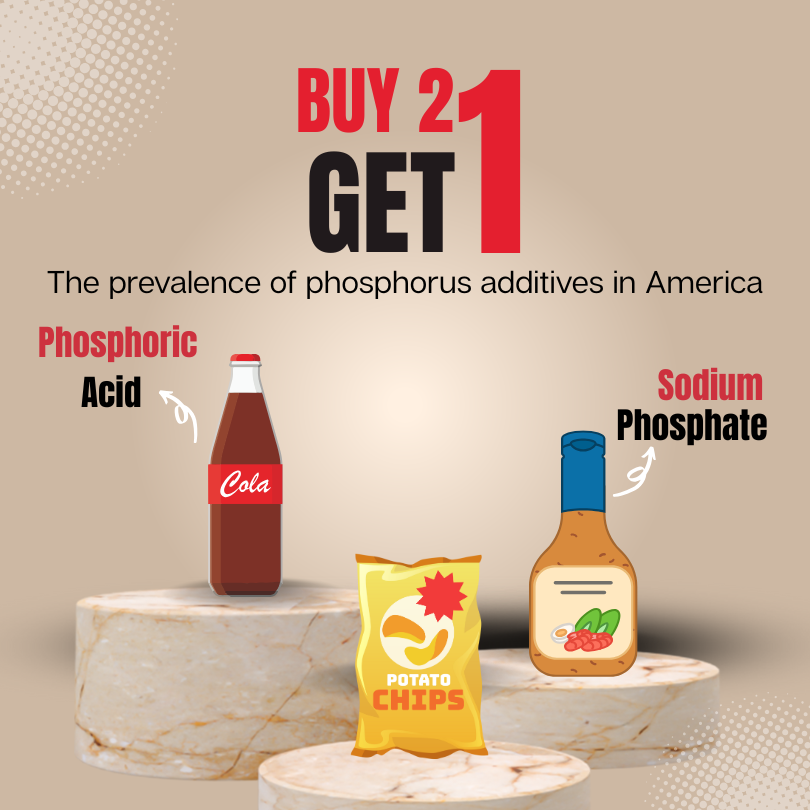The prevalence of phosphorus additives has been a growing concern (at least of my radar) for the last 10 years or so. But I can still struggle when I am talking with a patient about what foods they need to limit or avoid to reduce the amount of phosphorus additives in their diet. So, I was excited to see this 2025 article published in the American Journal of Clinical Nutrition, but famous phosphorus additive researcher Mona Calvo.
Full reference for today article:
What did they do?
The authors used sales revenue data available from Euromonitor Password. According to their website, Euromonitor report is a private company that collects data and provides sale reports for purchase. The report they used provided information on the top 25 food and beverage manufacturers in the US up to 2020.
After identifying the products, the researchers looked up product information on Label Insight. They used the ingredient lists provided on Label Insight to identify which foods contained phosphorus additives.
What phosphorus additives were considered?
As I have mentioned in my previous posts, some phosphorus additives are easy to spot because they have “phos” in the name (e.g. calcium phosphate or phosphoric acid). However other phosphorus additives are harder to spot because they have names like lecithin and disodium guanylate.
For this study, the authors searched for a total of 277 (I think I counted correctly) different terms for phosphorus additives (based on the information they provided in Supplemental table 1). This makes the authors Supplemental Table 1 the most comprehensive list of phosphorus additives that I have ever seen.
What did they find?
After removing some food items that were listed twice or lacked available ingredient lists, the researchers reviewed 39,937 products for the potential presence of additives.
Of these 56% of products contained one or more phosphorus additives. These products represent 52% of sales in the USA in 2020, representing over $120 billion worth of food sales!
What were the most common additives?
The most common additives were:
- Lecithin
- Sodium phosphate
- Calcium phosphate
- Modified food starches
- Sodium acid pyrophosphate.
However, when the authors broke it down by organic and inorganic phosphorus additives, the primary organic additives were:
- Sodium phosphate
- Calcium phosphate
- Sodium acid pyrophosphate
- Sodium Aluminum phosphate
- Potassium Phosphate.
The primary organic additives were:
- Lecithin
- Modified food starch
- Disodium Inositol
- Disodium guanosine
- Inositol
What foods contained phosphorus additives?
The top 3 categories with the highest proportion of phosphorus additives were:
- Energy drinks
- Sports drinks
- Baked goods
However, when they considered foods by sales share, the top 3 categories were:
- Savory snacks
- Confectionary
- Ready Meals
They also found that 32% of inorganic phosphorus additives were in beverages.
What brands contained phosphorus additives?
By sales, the top phosphorus additive contributing brands were:
- PepsiCo
- Kraft Heinz
- Coca-Cola
What does this article tell us?
That phosphorus additives are prevalent, with the key foods to watch being beverages, savory and sweet snacks and ready to eat meals.
The brands that are more likely to use phosphorus additives were PepsiCo, Kraft Heinz and Coco-Cola products.
What doesn’t this article tell us?
This article did not examine how the presence of these additives was associated with phosphorus content, so we can’t say for certain that all of these foods are necessarily high in phosphorus.
It also didn’t explore how consuming these foods is associated with changes in serum phosphorus levels specifically.
Take Aways
- The scientific community use the term phosphorus additives to refer to approximately 275 different ingredients added to ultra-processed foods.
- These additives appear in just over 1 out of every 2 foods sold in America.
- Manufacturers primarily add them to beverages, snack foods, bakery products, and ready-to-eat meals.


